June 2008
Welcome to this issue of the Hardwood Tree Improvement and Regeneration Center E-newsletter. The HTIRC is committed to enhancing the productivity and quality of Central Hardwood Region trees and forests for the economic and environmental benefits they provide. Scientists at the HTIRC are using conventional tree improvement breeding as well as molecular and genetic technologies to improve the wood quality, growth characteristics, and insect and disease resistance of trees like black walnut, black cherry, red and white oaks, butternut and American chestnut.
Research in tissue culture, tree nursery practices, tree plantation establishment and management, and Central Hardwoods silvicultural systems is aimed at increasing the regeneration success rate for high quality hardwood trees and forests. Some interesting and unusual research areas include examining the potential for propagating trees with “figured” wood: birds-eye maple or curly walnut; and breeding trees that will be an economical source of bio-fuels.
Twice per year, we will attempt to provide interesting and useful information on Central Hardwood trees and forests, as well as sources for additional information and assistance.
Please pass this newsletter along to others who may enjoy or benefit from the information provided. If you would like a closer look at the HTIRC, please visit our web site at: http://www.htirc.org
New Developments Provide Landowner Opportunities for Tree Planting
New Developments Provide Landowner Opportunities for Tree Planting
SAFE – State Acres for Wildlife Enhancement is a part of the Conservation Reserve Program (CRP) designed to provide habitat for endangered wildlife. This program is available for continuous signup, but limited to specific areas and practices designed to enhance habitat for wildlife species that are threatened, endangered, or have experienced population declines. This program provides significant incentives for enrollment, including a one-time sign-up bonus for some areas, up to 90% cost sharing for practice establishment, and 10 to 15 years of annual payments on enrolled acres. General program information can be found at http://www.fsa.usda.gov/Internet/FSA_File/safe08.pdf or from your county Farm Service Agency or Natural Resources Conservation Service office.
Of particular interest to landowners planning reforestation are the practices for hardwood tree planting and/or bottomland timber establishment.
You can check you eligibility and sign up at your county Farm Service Agency office.
Information on tree planting and plantation management is available from the Hardwood Tree Improvement and Regeneration Center: http://www.agriculture.purdue.edu/fnr/HTIRC/publications/landowners.html
Managed Woodland Carbon Offsets: A financial incentive to own and manage private woodlands
Woodland owners have the option to explore receiving payments for carbon sequestered in their forests. The Chicago Climate Exchange is accepting carbon sequestration offset credits from forest lands to be sold to businesses, industries, and other entities interested in voluntarily reducing their total carbon dioxide footprint. Sale of offsets from no-till or strip-till farming, grassland plantings, and tree plantings have been available to landowners for some time. Now, new guidance has been provided for landowners interested in selling accumulated carbon credits from their managed forest areas.
Some requirements for eligibility:
- You must have certification of sustainable forest management. If you are a member of a Tree Farm certification group, like Indiana’s Classified Forest system or Wisconsin’s Managed Forest Lands program, you pass this hurdle.
- You must commit to maintain your certification of sustainability for 15 years.
- You must have a forest inventory to establish a carbon baseline amount for the property. This inventory must be prepared by a qualified forester and meet certain requirements for the accuracy and type of data collected. If your inventory is more than 5 years old, you will need a new inventory. Guidance for landowners considering this option and foresters preparing these inventories is available at http://deltacarbon.org/aggregation/documents/XFO-ManagedForestContractP2E2.pdf
Other inventory methods may be accepted, but the landowner and forester should check with one of the aggregators that assist landowners in selling carbon to confirm the inventory can be used to establish the carbon baseline for the property. Here are some who work in this area:
The Delta Institute
53 West Jackson Boulevard
Suite 230
Chicago, Illinois 60604
312 554-0900
http://www.deltacarbon.org
The National Farmers Union
P.O. Box 2136
Jamestown, ND 58402
701-952-0116
http://www.nfu.org/issues/environment/carbon-credits/
AgraGate Climate Credits Corporation
5400 University Avenue
West Des Moines, IA 50266
866 633-6758
http://www.agragate.com/
FORECON EcoMarket Solutions
P.O. Box 837
Rockford, MI 49341
616 874-9934
http://www.foreconinc.com/ecomarket/
The above aggregators can assist you if you are interested in entering agricultural, grassland, tree plantings, or forest lands into the carbon offset programs.
Managed forests may sequester 1 to 3 tons of carbon per acre per year, based on some recent models and studies. Carbon is currently selling on the Chicago Climate Exchange for $6.50 to $7.50 per ton. You need to consider the cost of the inventory, costs to sell your carbon, and the conditions of the contract as you evaluate whether this fits in your property management objectives, but it does provide another income source for managed forest lands.
You can review the various carbon offset programs at the Chicago Climate Exchange (CCX) at http://www.chicagoclimateexchange.com/ or visit the aggregator sites above.
You can view a previous article on carbon credits at http://www.agriculture.purdue.edu/fnr/HTIRC/newsletter/2007/july.html
.
Doing your Part to Fight a Pest
A Emerald ash borer (EAB) continues to be in the news, and for good reason. The accidentally introduced beetle from Asia is chewing its way through native ash trees in parts of Illinois, Indiana, Ohio, Maryland, Michigan, Pennsylvania, and West Virginia. The result of the spread of this pest is dead ash in the urban and rural environment, costing landowners, companies, and governments millions of dollars in lost revenue, removal, and replacement costs, not to mention the environmental costs associated with the loss of this common tree species group. Since the beetles can only fly a mile or two at most, the greatest risk of spread is people unwittingly carrying the bug to new areas in material like firewood, landscape stock, logs, or products containing the bark and sapwood of ash. To avoid this accidental transfer of the pest, infested areas of the states mentioned have regulations prohibiting the movement of materials that could carry EAB to new areas. This quarantine is an important tool for preventing the rapid spread of EAB, so enforcement is rigorous and fines can be stiff. In areas not yet infested, people are being asked to not move hardwood firewood. Firewood can carry a variety of insects and diseases, so carrying firewood from one location to another, particularly if the wood will not be burned immediately, moves potential tree pests over wide areas much more quickly than they could spread naturally. Several current EAB infestation sites have been associated with firewood movement, so the best practice is to buy and use firewood locally.
Monitoring is an important tool used to determine where EAB is located and how far and fast it may be spreading. A new monitoring tool you may notice as you travel in EAB states is a large purple box suspended or attached to a tree . This box has been treated with an oil that attracts EAB adults which become entangled in the glue on the panels.
A new tool for protecting ash trees against EAB attack is also available. Tree-äge, an emamectin benzoate-based pesticide developed over the past four years by the Swiss agrochemical company Syngenta and the Massachusetts firm Arborjet has proven very effective in killing both the larval and adult life stages of EAB. Tree-äge is not directly available to landowners, but must be applied by certified pesticide applicators. It is a systemic insecticide, so trees with vascular systems already badly damaged by EAB may not respond as well as healthy trees. Contact an arborist to see if this material might be the right choice for saving individual ash trees on your property. Imidacloprid, which is available in both homeowner and professional formulations, has also been effective as a preventative treatment against EAB infestation of individual ash trees.
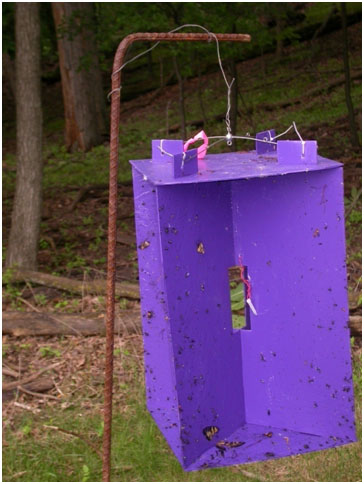
Emerald ash borer survey employees will be hanging purple panel traps in trees throughout the state. The traps, baited with manuka oil to attract nearby emerald ash borers, will continue to hang until survey employees begin removing them in September. (Purdue University photo)
For additional information:
Emerald Ash Borer national and state news and information: http://www.emeraldashborer.info/
Emerald Ash Borer and Ash Germplasm Collections
The tragic news of the emerald ash borer and its consequences has reached the ears of most people by now. What will exactly happen to the ash resource is not presently known but genetics will undoubtedly play a major role in ash recovery plans. To insure a broadly adapted ash genetic resource HTIRC staff Bob Karrfalt and Ron Overton are organizing ash seed collections in cooperation with DNR staffs in the most heavily infested states of Indiana, Ohio, and Michigan. Initial collection work began in 2006 and these first steps helped develop efficient protocols for collection and handling the seeds. This coming fall the crop looks to be very good. Substantial progress on the collections is possible this fall because of this good seed crop. Funding from the USDA Forest Service, Forest Health program and the cooperation of the state DNR’s will go a long way to making this a reality. Collections will need to be made for a number of years into the future as the EAB spreads across the range of the ash trees.
Once the seeds are collected they will be transmitted to the HTIRC for cleaning and preparation for freezer storage. Most seeds will be made available by the HTIRC and the Forest Service National Seed Laboratory (http://www.nsl.fs.fed.us) for research related to the EAB and ash recovery work. Some will be placed in long term security back up at the Agricultural Research Service’s (ARS) Center for Genetic Resource Preservation in Fort Collins Colorado. All seed lots will be entered into the ARS National Plant Germplasm System (http://www.ars-grin.gov/npgs/ ) for long term preservation.
The recovery of ash could come in many ways. One way is hybridizing with Asian ash species as is being done with American chestnut. A second might be the use of genetic transformations using the genes from Asian species or perhaps a Bt gene. A third is that the EAB may be brought under control by predators, disease, or management practices. Whatever the solution, it will depend on an abundant supply of well adapted genetic material. This seed collection effort will insure the material will be available.
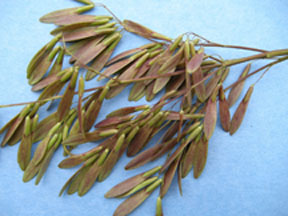
Anyone interested in learning more about this effort or in assisting with it can contact Bob Karrfalt at karrfalt@purdue.edu.
Early Success in Tree Plantings: Predation
Successful establishment of conservation tree plantings can be a challenging exercise for landowners and resource professionals. In the previous newsletter, we discussed the importance of managing the competition created by surrounding vegetation. In this article we will explore management of predation.
Predation by a variety of animals and diseases can be a major barrier to successful seedling establishment and growth. Predation can take the form of consumption of parts of the seedling, physical damage to parts of the seedling from activities like deer antler rubbing, and insect and disease attacks.
One of the most common predation problems is browsing of twigs, bark, and foliage by deer, rabbits, rodents, or other herbivores. The intensity and timing of browsing can strongly influence the potential survival and growth of planted seedlings. Areas with high browsing pressure may experience death of preferred browse species, but more commonly, new shoots and leaves are continually cropped back, preventing height growth. If seedlings are protected from browsing, or browsing animal populations are reduced, or their access limited in the area of the planting, the seedlings may be able to grow in height or diameter to a size where damage to tree parts is no longer a threat to growth or survival.
Deer may be the most common source of animal damage to tree seedlings, by both browsing and antler rubbing on seedlings and saplings. There are several approaches that could be used individually or in combination to help reduce damage to seedlings. Where the value of the planting warrants it, fencing is the most reliable method for preventing damage. Fences form a physical or psychological barrier to deer, depending on their construction. Several fencing methods are available, each having strengths and weaknesses. Physical barrier fencing must be tall and/or wide enough to discourage deer from entering. Minimum height for effective exclusion of deer is 7.5 to 8 feet for single-row vertical fence. A variety of metal and plastic mesh or wire strand fence designs are available. Materials and installation may be expensive, but maintenance is generally low and effectiveness of deer exclusion is high. Another design option is fencing using multiple fence rows, or posts set at an angle from vertical to form a horizontally deep fence that discourages deer .
Electrified fencing using baited or highly visible cords or banding presents a psychological barrier to deer entry, once the deer experience a jolt from the fence. These fences generally require more maintenance than the physical barrier fencing, but installation is fairly simple, and some of the systems are very portable, providing the option of re-using the fencing in new areas.
Tree tubes and wire or mesh cages can also be used to keep deer away from the seedlings. Tubes or cages will generally need to be 5 or more feet tall in most areas to provide reliable protection to the seedling growing tips.
A variety of materials designed to repel deer by means of odor or taste are available, and have demonstrated various levels of success. “Home remedies” like soap bars, human hair, blood products, or the waste of predators have been used with some reported success as well. These products may need to be re-applied several times during the year to remain effective.
Another important aspect of managing deer damage is population management to prevent deer from reaching population levels that adversely impact the regeneration of tree plantings and forest areas. This is an approach that needs to be applied on a scale that exceeds the size of most individual property ownerships, so communication and cooperation with neighbors and wildlife management agencies is important to success.
Vegetation management can also be used to reduce deer damage. Allowing briars or annual weeds to grow up around the seedlings can help screen seedlings from deer. Consideration should be given to balancing prevention of deer damage with the level of competition created by the weed growth. Deer will have preferred browse species that may vary by season and region of the country, so recognition of species that may be more attractive to deer can help in planning for deer damage control measures. A recent survey of professional foresters in Indiana rated northern red oak and several other oak species as some of the most preferred deer browse species. An approach that has become popular with some tree planters is increasing the number of trees planted per acre to account for increased deer browsing losses.
Rabbits and rodents can also cause damage by chewing roots, bark, stems and twigs. These species are preyed upon by many other animals, so the presence of cover is important to their survival. By limiting the amount of feeding, nesting, and escape cover near your trees, much of this damage can be avoided. Good weed control around seedlings will help limit damage since less habitat is available and rabbits and rodents will be more exposed to predators like hawks, owls, coyote, fox, and others. It is a paradox of tree planting that, although many plantings are installed to provide some wildlife habitat, we often need to limit wildlife use until the trees and shrubs can become established.
Damage to trees by insects and diseases is usually related to three factors:
- The introduction of exotic pests to which our native plants have no natural resistance can result in functional elimination of some species. Examples include chestnut blight and American chestnut, and Emerald Ash Borer and native ash species. In these cases, we are often forced to limit our planting of the affected tree until management, treatments, or breeding produce disease management options.
- Planting trees and shrubs on sites that don’t match their growth needs. This results in stress to the plant that makes it susceptible to attack by insect s and diseases. Always carefully match the species planted to the site characteristics.
- Occasional population explosions of pest species. Many plant pests have population spikes that result in a season or two of increased damage, but populations often crash after that, allowing trees to recover. .
It can be logistically and financially very challenging to eliminate all sources of seedling predation, but appropriate management can help keep damage within acceptable limits.
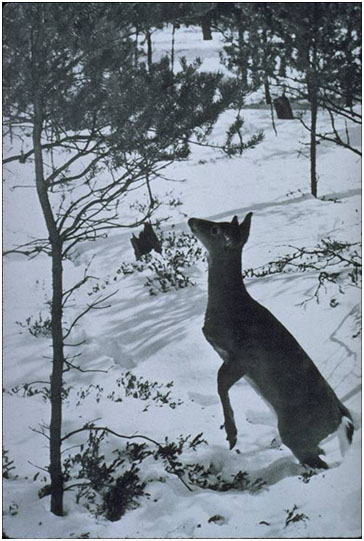
When browse is in short supply, deer populations are high, or a food source is highly preferred, deer can be a very persistent tree predator.
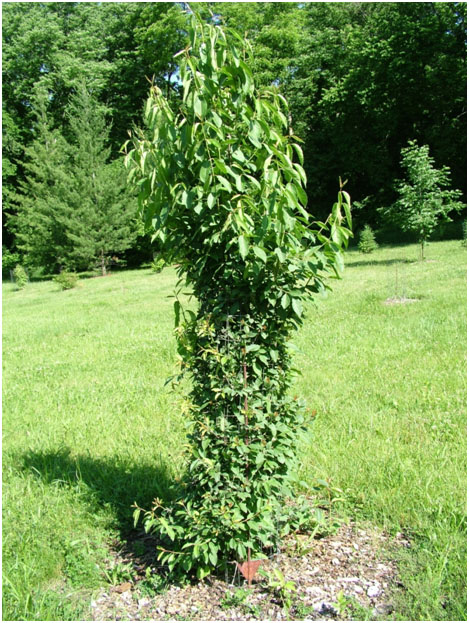
A wire cage protects the upper buds and stems of this seedling from being browsed and keeps rabbits away from the bark. Deer continue to browse the lower stems, but the seedling is now free to grow in height and has an improved chance of survival and normal development.
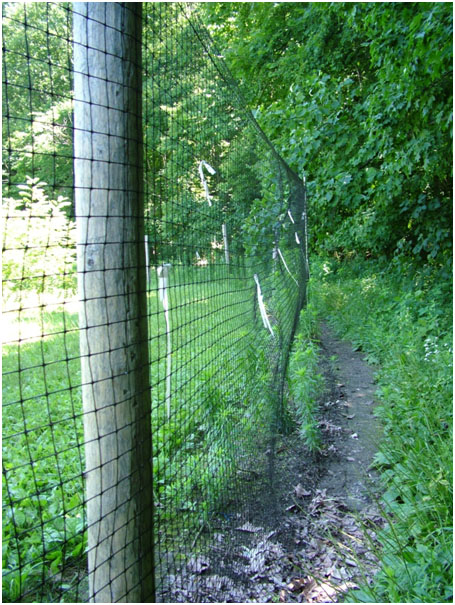
The HTIRC uses a 7.5 foot plastic mesh fence to protect seedlings from deer damage. This fence has a shorter life span than metal mesh fencing, but is easier and less expensive to install, and lasts long enough to allow seedlings to grow past deer browse threats to the terminal buds.
Additional Information:
Purdue Department of Forestry and Natural Resources, Coping with Wildlife Damage site: http://www.agriculture.purdue.edu/fnr/wildlife/landowners/wildlifedamage.html
HTIRC wildlife damage control publication: http://www.extension.purdue.edu/extmedia/FNR/FNR-216.pdf
University of Missouri deer damage control publication: http://extension.missouri.edu/xplor/miscpubs/mp0685.htm
American Chestnut – Reviving a Giant of the Eastern Forest
American chestnut was a dominant component of the eastern hardwood forest from Maine to Alabama and extended west into Southern Indiana, Western Tennessee and Kentucky, and Mississippi. It was perhaps the most important eastern hardwood tree species and may have accounted for one fourth of the hardwood trees in parts of its range. In 1904 some American chestnuts began dying in New York. The cause was an accidentally introduced fungal blight from Asia that quickly moved through the native range of chestnut, killing nearly every tree in its path. By the mid 1900’s, only stump sprouts and isolated American chestnut trees remained. When no American chestnuts could be found with resistance to the blight, programs were started to develop a hybrid chestnut with the straight form and nut production that made American chestnut a premier timber and wildlife tree, and also blight resistance found in Asian chestnut species.
Currently, the Hardwood Tree Improvement and Regeneration Center (HTIRC) is cooperating with The American Chestnut Foundation (TACF) in research and testing to restore an American chestnut back-crossed hybrid to hardwood forests and plantings. Through back-crossing American/Chinese chestnut hybrids with pure American chestnut, a hybrid tree that has the physical characteristics of the American chestnut with the chestnut blight resistance of the Chinese species has been developed. Reintroduction of this disease resistant tree may begin in as few as 7 to 10 years as seed orchards begin to produce adequate quantities of nuts for distribution. As reintroduction through planting becomes a reality, natural resource managers, tree planters, and landowners will need information on the best ways to plant and manage American chestnut in a variety of situations and sites. Since this tree was functionally extinct before research work was done on its regeneration and growth characteristics, the HTIRC is working with TACF and other partners to propagate disease-resistant tree families, test for disease resistance, determine growth characteristics, response to varying site conditions, and how it can be managed in plantations and woodlands. Examination of plantings containing black walnut, northern red oak and American chestnut planted over 12 years ago by Dr. Larry Severeid in southwestern Wisconsin was conducted by HTIRC Regeneration Silviculturist Doug Jacobs, indicating American chestnut consistently out-performed both walnut and red oak in diameter and height growth. Dr. Jacobs has installed additional test plantings on Purdue University Department of Forestry and Natural Resources property to examine competition dynamics between black cherry, northern red oak, and American chestnut. Historical and current evidence suggests American chestnut may be one of the fastest growing fine hardwoods.
Field and greenhouse tests are being conducted by HTIRC and other scientists to determine how American chestnut responds to various levels of light, moisture, and nutrients. Historical evidence combined with more recent research indicates this tree is somewhat of a generalist that can occupy a variety of sites, but prefers acidic soils with good drainage. It seems to make its best growth in full sunlight, but can tolerate lower light levels, allowing seedlings and sprouts to build up in the forest understory until a disturbance creates an opening. The trees are able to respond rapidly to this available space and grow quickly, often out-competing other seedlings. The capacity to build up a regeneration pool, and grow rapidly once the seedlings are exposed to light may allow for more flexibility in management systems and a greater chance for successful regeneration compared to species like oak. The rapid growth rate and rot-resistant wood of American chestnut lends itself to timber production and perhaps carbon sequestration management. The abundant annual nut crop was a mainstay for many species of wildlife as well as a food and cash-crop item for communities in the historical range of American chestnut.
Chestnut blight is not the only threat to American chestnut. The fungus Phytophthora cinnamomi
can infect and kill trees, with infection commonly associated with compacted or other poorly drained soils. Planting on well-drained soils is recommended to reduce the risk of infection. Ambrosia beetles can infest stems and introduce a Fusarium fungus that can subsequently kill small trees. HTIRC scientists Matt Ginzel, Entomologist, and Jim McKenna, Tree Breeder, reported 3% mortality and an additional 5 to 8% stem dieback in HTIRC chestnut plantings due to ambrosia beetle/Fusarium infection. A preventative insecticide application in May is being used to manage this problem.
The HTIRC planted over 500 new back-crossed seedlings into chestnut orchards in 2007 and, in cooperation with the Indiana DNR Division of Forestry nurseries, will have many more back-crossed and pure American chestnut seedlings for research plantings this year. In addition, back-crossed chestnuts have been successfully grafted, providing another propagation technique to reproduce blight resistant trees. The efforts of TACF, HTIRC, and many partners around the country are bringing us one step closer to placing a forest giant back in the landscape.

Container chestnut seedlings being prepared for planting.
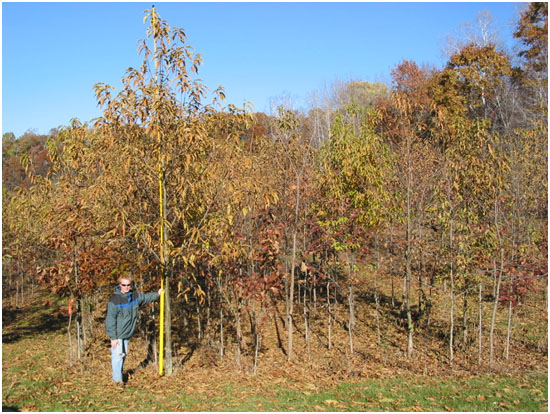
American chestnut interplanted with northern red oak and black walnut on the tree farm of Dr. Larry Severeid in southwestern Wisconsin.
For additional information:
The American Chestnut Foundation: http://www.acf.org/
HTIRC research on chestnut: http://www.agriculture.purdue.edu/fnr/HTIRC/publications/research.html#HwdRegAmerChestnut
HTIRC news articles on chestnut: http://www.agriculture.purdue.edu/fnr/HTIRC/news/general.html
